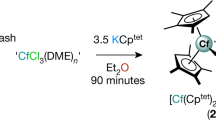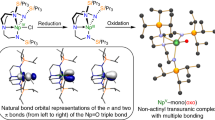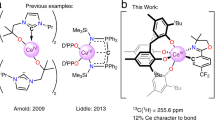Abstract
The actinides, from californium to nobelium (Z = 98–102), are known to have an accessible +2 oxidation state. Understanding the origin of this chemical behaviour requires characterizing CfII materials, but investigations are hampered by the fact that they have remained difficult to isolate. This partly arises from the intrinsic challenges of manipulating this unstable element, as well as a lack of suitable reductants that do not reduce CfIII to Cf°. Here we show that a CfII crown–ether complex, Cf(18-crown-6)I2, can be prepared using an Al/Hg amalgam as a reductant. Spectroscopic evidence shows that CfIII can be quantitatively reduced to CfII, and rapid radiolytic re-oxidation in solution yields co-crystallized mixtures of CfII and CfIII complexes without the Al/Hg amalgam. Quantum-chemical calculations show that the Cf‒ligand interactions are highly ionic and that 5f/6d mixing is absent, resulting in weak 5f→5f transitions and an absorption spectrum dominated by 5f→6d transitions.

This is a preview of subscription content, access via your institution
Access options
Access Nature and 54 other Nature Portfolio journals
Get Nature+, our best-value online-access subscription
$29.99 / 30 days
cancel any time
Subscribe to this journal
Receive 12 print issues and online access
$259.00 per year
only $21.58 per issue
Buy this article
- Purchase on Springer Link
- Instant access to full article PDF
Prices may be subject to local taxes which are calculated during checkout





Similar content being viewed by others
Data availability
All of the relevant data that support the findings of this research are available within the Article and its Supplementary Information and via CCDC 2180138 (Dy(18-crown-6)I2) (https://www.ccdc.cam.ac.uk/structures/Search?access=referee&ccdc=2180138&Author=Todd+Poe), 2180139 ([Am(cis-syn-cis-dicyclohexano-18-crown-6)(H2O)(CH3CN)I]I2·CH3CN) (https://www.ccdc.cam.ac.uk/structures/Search?access=referee&ccdc=2180139&Author=Todd+Poe), 2180140 (Cf(18-crown-6)I2) (https://www.ccdc.cam.ac.uk/structures/Search?access=referee&ccdc=2180140&Author=Todd+Poe) and 2180141 ([CfII(18-crown-6)(H2O)2(CH3CN)][CfIII(18-crown-6)(H2O)(CH3CN)I]I2) (https://www.ccdc.cam.ac.uk/structures/Search?access=referee&ccdc=2180141&Author=Todd+Poe). Source data are provided with this paper.
References
Clark, D. L. The chemical complexities of plutonium. Los Alamos Sci 26, 364–381 (2000).
Morss, L. R., Edelstein, N. M. & Fuger, J. The Chemistry of the Actinide and Transactinide Elements (Springer, 2010).
Haire, R. G. in The Chemistry of the Actinide and Transactinide Elements (eds Morss, L. R., Edelstein, N. M. & Fuger, J.) 1499–1576 (Springer, 2010).
Maly, J., Sikkeland, T., Silva, R. & Ghiorso, A. Nobelium: tracer chemistry of the divalent and trivalent ions. Science 160, 1114–1115 (1968).
Silva, R. J. in The Chemistry of the Actinide and Transactinide Elements (eds Morss, L. R., Edelstein, N. M. & Fuger, J.) 1621–1652 (Springer, 2010).
Mikheev, Ν. Β, Auerman, L. Ν, Rumer, I. A., Kamenskaya, A. N. & Kazakevich, Μ. Ζ The anomalous stabilisation of the oxidation state 2+ of lanthanides and actinides. Russ. Chem. Rev. 61, 990–998 (1992).
Langeslay, R. R., Fieser, M. E., Ziller, J. W., Furche, F. & Evans, W. J. Synthesis, structure and reactivity of crystalline molecular complexes of the {[C5H3(SiMe3)2]3Th}1− anion containing thorium in the formal +2 oxidation state. Chem. Sci. 6, 517–521 (2014).
Woen, D. H. & Evans, W. J. Expanding the +2 oxidation state of the rare-earth metals, uranium and thorium in molecular complexes. Handb. Phys. Chem. Rare Earths 50, 337–394 (2016).
Su, J. et al. Identification of the formal +2 oxidation state of neptunium: synthesis and structural characterization of {NpII[C5H3(SiMe3)2]3}1−. J. Am. Chem. Soc. 140, 7425–7428 (2018).
Windorff, C. J. et al. Identification of the formal +2 oxidation state of plutonium: synthesis and characterization of {PuII[C5H3(SiMe3)2]3}−. J. Am. Chem. Soc. 139, 3970–3973 (2017).
Dutkiewicz, M. S., Apostolidis, C., Walter, O. & Arnold, P. L. Reduction chemistry of neptunium cyclopentadienide complexes: from structure to understanding. Chem. Sci. 8, 2553–2561 (2017).
Straub, M. D. et al. A uranium(II) arene complex that acts as a uranium(I) synthon. J. Am. Chem. Soc. 143, 19748–19760 (2021).
Lapierre, H. S., Kameo, H., Halter, D. P., Heinemann, F. W. & Meyer, K. Coordination and redox isomerization in the reduction of a uranium(III) monoarene complex. Angew. Chem. Int. Ed. 53, 7154–7157 (2014).
Murillo, J. et al. Actinide arene-metalates: ion pairing effects on the electronic structure of unsupported uranium-arenide sandwich complexes. Chem. Sci. 12, 13360–13372 (2021).
Dau, P. D., Shuh, D. K., Sturzbecher-Hoehne, M., Abergel, R. J. & Gibson, J. K. Divalent and trivalent gas-phase coordination complexes of californium: evaluating the stability of Cf(II). Dalton Trans. 45, 12338–12345 (2016).
Schöttle, C. et al. Nanosized gadolinium and uranium—two representatives of high-reactivity lanthanide and actinide metal nanoparticles. ACS Omega 2, 9144–9149 (2017).
Marsh, M. L. et al. Electrochemical studies of selected lanthanide and californium cryptates. Inorg. Chem. 58, 9602–9612 (2019).
David, F., Samhoun, K., Guillaumont, R. & Edelstein, N. Thermodynamic properties of 5f elements. J. Inorg. Nucl. Chem. 40, 69–74 (1978).
Bard, A. J. Standard Potentials in Aqueous Solution (International Union of Pure and Applied Chemistry, 1985).
Silver, M. A. et al. Electronic structure and properties of Berkelium iodates. J. Am. Chem. Soc. 139, 13361–13375 (2017).
Wild, J. F. et al. Studies of californium(II) and (III) iodides. J. Inorg. Nucl. Chem. 40, 811–817 (1978).
White, F. D. et al. Molecular and electronic structure, and hydrolytic reactivity of a samarium(II) crown ether complex. Inorg. Chem. 58, 3457–3465 (2019).
Poe, T. N., Molinari, S., Justiniano, S., McLeod, G. M. & Albrecht-Schönzart, T. E. Structural and spectroscopic analysis of Ln(II) 18-crown-6 and benzo-18-crown-6 complexes (Ln = Sm, Eu, Yb). Cryst. Growth Des. 22, 842–852 (2022).
Brown, D., Fletcher, S. & Holah, D. G. The preparation and crystallographic properties of certain lanthanide and actinide tribromides and tribromide hexahydrates. J. Chem. Soc. A 67, 1889–1894 (1968).
Xémard, M. et al. Divalent thulium crown ether complexes with field-induced slow magnetic relaxation. Inorg. Chem. 58, 2872–2880 (2019).
Merzlyakova, E. et al. 18-Crown-6 coordinated metal halides with bright luminescence and nonlinear optical effects. J. Am. Chem. Soc. 143, 798–804 (2021).
Rogers, R. D., Rollins, A. N., Etzenhouser, R. D., Voss, E. J. & Bauer, C. B. Structural investigation into the steric control of polyether complexation in the lanthanide series: macrocyclic 18-crown-6 versus acyclic pentaethylene glycol. Inorg. Chem. 32, 3451–3462 (1993).
Rogers, R. D. et al. Direct comparison of the preparation and structural features of crown ether and polyethylene glycol complexes of NdCl3·6H2O. Inorg. Chem. 30, 4946–4954 (1991).
Rogers, R. D., Kurihara, L. K. & Voss, E. J. f-Element/crown ether complexes. 5.1 Structural changes in complexes of lanthanide chloride hydrates with 18-crown-6 accompanying decreases in Ln3+ ionic radii: synthesis and structures of [M(OH2)7 (OHMe)][MCl(OH2)2(18-crown-6)]2Cl7·2H2O (M = Y, Dy). Inorg. Chem. 26, 2360–2365 (1987).
Rogers, R. D. & Kurihara, L. K. f-Element/crown ether complexes. 4. Synthesis and crystal and molecular structures of [MCl(OH2)2(18-crown-6)]Cl2·2H2O (M = Sm, Gd, Tb). Inorg. Chem. 26, 1498–1502 (1987).
Polinski, M. J. et al. Differentiating between trivalent lanthanides and actinides. J. Am. Chem. Soc. 134, 10682–10692 (2012).
Sperling, J. M. et al. Pressure-induced spectroscopic changes in a californium 1D material are twice as large as found in the holmium analog. Inorg. Chem. 59, 10794–10801 (2020).
Apostolidis, C. et al. [An(H2O)9](CF3SO3)3 (An = U–Cm, Cf): Exploring their stability, structural chemistry and magnetic behavior by experiment and theory. Angew. Chem. Int. Ed. 49, 6343–6347 (2010).
Brenner, N. et al. Trivalent f-element squarates, squarate-oxalates, and cationic materials, and the determination of the nine-coordinate ionic radius of Cf(III). Inorg. Chem. 59, 9384–9395 (2020).
Wang, S., Alekseev, E. V., Depmeier, W. & Albrecht-Schmitt, T. E. Surprising coordination for plutonium in the first plutonium(III) borate. Inorg. Chem. 50, 2079–2081 (2011).
Mironov, Y. V., Cody, J. A., Albrecht-Schmitt, T. E. & Ibers, J. A. Cocrystallized mixtures and multiple geometries: syntheses, structures and NMR spectroscopy of the Re6 clusters [NMe4]4[Re6(Te(8 − n)Se(n))(CN)6] (n = 0–8). J. Am. Chem. Soc. 119, 493–498 (1997).
Peterson, J. R., Fellows, R. L., Young, J. P. & Haire, R. G. Stabilization of californium(II) in the solid-state – californium dichloride, 249CfCl2. Radiochem. Radioanal. Lett. 31, 277–282 (1977).
Peterson, J. R. & Baybarz, R. D. The stabilization of divalent californium in the solid state: californium dibromide. Inorg. Nucl. Chem. Lett. 8, 423–431 (1972).
Young, J. P., Vander Sluis, K. L., Werner, G. K., Peterson, J. R. & Noé, M. High temperature spectroscopic and X-ray diffraction studies of californium tribromide: proof of thermal reduction to californium(II). J. Inorg. Nucl. Chem. 37, 2497–2501 (1975).
Izatt, R. M., Haymore, B. L., Bradshaw, J. S. & Christensen, J. J. Facile separation of the cis isomers of dicyclohexyl-18-crown-6. Inorg. Chem. 14, 3132–3133 (2002).
Sheldrick, G. M. SHELXT—integrated space-group and crystal-structure determination. Acta Crystallogr. A Found. Crystallogr. 71, 3–8 (2015).
Dolomanov, O. V., Bourhis, L. J., Gildea, R. J., Howard, J. A. K. & Puschmann, H. OLEX2: a complete structure solution, refinement and analysis program. J. Appl. Crystallogr. 42, 339–341 (2009).
Poe, T. N. et al. Influence of outer-sphere anions on the photoluminescence from samarium(II) crown complexes. Inorg. Chem. 60, 15196–15207 (2021).
te Velde, G. et al. Chemistry with ADF. J. Comput. Chem. 22, 931–967 (2001).
Van Lenthe, E., Baerends, E. J. & Snijders, J. G. Relativistic regular two-component Hamiltonians. J. Chem. Phys. 99, 4597–4610 (1993).
Greer, R. D. M. et al. Structure and characterization of an americium bis(O,O′-diethyl)dithiophosphate complex. Inorg. Chem. 59, 16291–16300 (2020).
Gaiser, A. N. et al. Creation of an unexpected plane of enhanced covalency in cerium(III) and berkelium(III) terpyridyl complexes. Nat. Commun. 12, 7230 (2021).
Ramanantoanina, H. LFDFT—a practical tool for coordination chemistry. Computation 10, 70 (2022).
Ramanantoanina, H., Urland, W., Cimpoesu, F. & Daul, C. The angular overlap model extended for two-open-shell f and d electrons. Phys. Chem. Chem. Phys. 16, 12282–12290 (2014).
Judd, B. R. Optical absorption intensities of rare-earth ions. Phys. Rev. 127, 750–761 (1962).
Ofelt, G. S. Intensities of crystal spectra of rare-earth ions. J. Chem. Phys. 37, 511–520 (1962).
Glendening, E. D., Landis, C. R. & Weinhold, F. NBO 6.0: natural bond orbital analysis program. J. Comput. Chem. 34, 1429–1437 (2013).
Neese, F., Wennmohs, F., Becker, U. & Riplinger, C. The ORCA quantum chemistry program package. J. Chem. Phys. 152, 224108 (2020).
Acknowledgements
This research was supported by the US Department of Energy, Office of Science, Office of Basic Energy Sciences, Heavy Elements Chemistry Program, under award no. DE-FG02-13ER16414.
Author information
Authors and Affiliations
Contributions
T.N.P., J.M.S., H.B.W., B.M.R., B.S., N.B., B.N.L., S.J. and T.E.A.-S. contributed to the conception and execution of the synthetic, spectroscopic, and crystallographic studies reported in this manuscript. T.N.P., J.M.S., H.B.W., B.M.R., J.B., Z.B., N.B. and B.N.L. contributed to the recycling and purification of 249Cf between experiments. H.R. and C.C.-B. carried out the computational studies. All authors discussed and co-wrote the manuscript.
Corresponding authors
Ethics declarations
Competing interests
The authors declare no competing interests.
Peer review
Peer review information
Nature Chemistry thanks the anonymous reviewer(s) for their contribution to the peer review of this work.
Additional information
Publisher’s note Springer Nature remains neutral with regard to jurisdictional claims in published maps and institutional affiliations.
Extended data
Extended Data Fig. 1 Canonical molecular orbital energy diagram.
The orbital splitting obtained from spin-orbit CASSCF calculations, CAS(10,12), is consistent with a pseudo-D6h. Molecular orbitals in the active space are shown. The predicted spin-orbit ground state corrected by dynamic correlation is 72% 5I8 and 12% 3K8 (plus additional smaller contributions).
Extended Data Fig. 2 LFDFT absorption spectroscopy of [CfII(18-crown-6)(H2O)2(CH3CN)]2-.
Calculated absorption spectrum using the LFDFT approach, where a) the calculated intensities of the 5f→6d transitions obscure most of the 5f→5f transitions. The inset corresponds to the most intense 5f→5f transition consistent with the experimental spectrum. b) The 5f→5f transitions were zoomed in and the lowest lying states assigned. It is clear that the low intensity transitions J = 5 and J = 2 are significantly affected by the ∆S = 0 selection rule, and that there is strong J-mixing (bracketed in bold).
Extended Data Fig. 3 Solid-state absorption spectrum of [CfII(18-crown-6)(H2O)2(CH3CN)][CfIII(18-crown-6)(H2O)(CH3CN)I]I2.
The solid-state absorption spectra for crystals [CfII(18-crown-6)(H2O)2(CH3CN)][CfIII(18-crown-6)(H2O)(CH3CN)I]I2 collected at room temperature (green) and 93.15 K (black) possess similar features in the UV region to the broadband features observed in the solution absorption spectrum containing [Cf(18-crown-6)]3+ presented in Fig. 3.
Extended Data Fig. 4 Crystal structure of [Am(cis-syn-cis-dicyclohexano-18-crown-6)(H2O)(CH3CN)I]I2 • CH3CN and associated bond lengths.
a) and b) Preparation of AmI3 • nH2O (n ≤ 6) can be performed using the same methods reported for CfI3 • nH2O (n ≤ 6). Reaction of AmI3 • nH2O (n ≤ 6) with dicyclohexano-18-crown-6 and [NBu4][BPh4] in acetonitrile yields crystals of [Am(cis-syn-cis-dicyclohexano-18-crown-6)(H2O)(CH3CN)I]I2 • CH3CN after slow vapor diffusion of diethyl ether. (a) Features a view of the isolated metal complex showing the ligands in apical positions, while (b) shows the coordination of the dicyclohexano-18-crown-6 molecule in the equatorial plane of the molecule. c) A table of bond lengths for the metal complex is provided for comparison with the Cf complexes reported here, as well as similar Am complexes reported in the literature.
Extended Data Fig. 5 Solid-state absorption spectrum of [Am(cis-syn-cis-dicyclohexano-18-crown-6)(H2O)(CH3CN)I]I2 • CH3CN.
Solid-state absorption measurements of [Am(cis-syn-cis-dicyclohexano-18-crown-6)(H2O)(CH3CN)I]I2 • CH3CN yield characteristic 5f→5f transitions exhibited by this compound, namely group E transitions (7F6) at 19,763 cm−1 and hypersensitive group H transitions (5L6) at 12,207 cm−1.
Extended Data Fig. 6 Geometry optimization structure of the Cf mixed valent compound.
Depiction of the 13 iodide anions considered in the geometry optimization of the [CfII(18-crown-6)(H2O)2(CH3CN)][CfIII(18-crown-6)(H2O)(CH3CN)I]I2 complexes. Their positions were kept fixed in the optimization process.
Extended Data Fig. 7 Potential energy surfaces of the three possible assignments for apical ligands.
a) [CfIII(18-crown-6)(H2O)(CH3CN)(OH)]2- b) [CfII(18-crown-6)(H2O)2(CH3CN)]2- and c) [CfIII(18-crown-6)(H2O)(CH3CN)I]2-. Energies correspond to relative energies with respect to their corresponding minimum values in kJ/mol. Solid lines correspond to data fitting curves using quartic functions (R2 = 1 for each case). Distances at the minimum energy value are given for each case.
Supplementary information
Supplementary Information
Supplementary figs. 1–5, discussion and tables 1 and 2.
Supplementary Data 1
Source data for plots.
Supplementary Data 2
Crystal structure of Cf(18-crown-6)I2.
Supplementary Data 3
Crystal structure containing [Cf(18-crown-6)(H2O)2(CH3CN)][CfI(18-crown-6)(H2O)(CH3CN)I]2+.
Supplementary Data 4
Crystal structure of [Am(cis-syn-cis-dicyclohexano-18-crown-6)(H2O)(CH3CN)I]I2•CH3CN.
Supplementary Data 5
Crystal structure of Dy(18-crown-6)I2.
Source data
Source Data Fig. 4
Source data for plots.
Source Data Fig. 5
Source data for plots.
Source Data Extended Data Fig. 2
Source data for plots.
Source Data Extended Data Fig. 3
Source data for plots.
Source Data Extended Data Fig. 5
Source data for plots.
Source Data Extended Data Fig. 7
Source data for plots.
Rights and permissions
Springer Nature or its licensor (e.g. a society or other partner) holds exclusive rights to this article under a publishing agreement with the author(s) or other rightsholder(s); author self-archiving of the accepted manuscript version of this article is solely governed by the terms of such publishing agreement and applicable law.
About this article
Cite this article
Poe, T.N., Ramanantoanina, H., Sperling, J.M. et al. Isolation of a californium(II) crown–ether complex. Nat. Chem. 15, 722–728 (2023). https://doi.org/10.1038/s41557-023-01170-9
Received:
Accepted:
Published:
Issue Date:
DOI: https://doi.org/10.1038/s41557-023-01170-9



